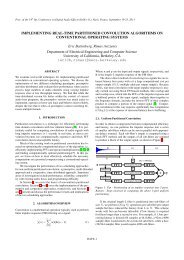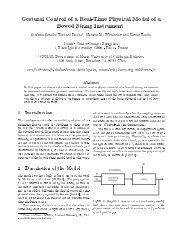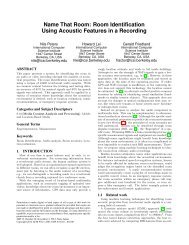PIC18F97J60 Family Device Data Sheet - CNMAT
PIC18F97J60 Family Device Data Sheet - CNMAT
PIC18F97J60 Family Device Data Sheet - CNMAT
You also want an ePaper? Increase the reach of your titles
YUMPU automatically turns print PDFs into web optimized ePapers that Google loves.
<strong>PIC18F97J60</strong> FAMILY<br />
2.7.1.1 System Clock Selection and the<br />
FOSC2 Configuration Bit<br />
The SCS bits are cleared on all forms of Reset. In the<br />
device’s default configuration, this means the primary<br />
oscillator defined by FOSC1:FOSC0 (that is, one of the<br />
HC or EC modes) is used as the primary clock source<br />
on device Resets.<br />
The default clock configuration on Reset can be changed<br />
with the FOSC2 Configuration bit. This bit affects the<br />
clock source selection setting when SCS1:SCS0 = 00.<br />
When FOSC2 = 1 (default), the oscillator source<br />
defined by FOSC1:FOSC0 is selected whenever<br />
SCS1:SCS0 = 00. When FOSC2 = 0, the INTRC oscillator<br />
is selected whenever SCS1:SCS2 = 00. Because the<br />
SCS bits are cleared on Reset, the FOSC2 setting also<br />
changes the default oscillator mode on Reset.<br />
Regardless of the setting of FOSC2, INTRC will always<br />
be enabled on device power-up. It will serve as the<br />
clock source until the device has loaded its configuration<br />
values from memory. It is at this point that the<br />
FOSC Configuration bits are read and the oscillator<br />
selection of operational mode is made.<br />
Note that either the primary clock or the internal<br />
oscillator will have two bit setting options, at any given<br />
time, depending on the setting of FOSC2.<br />
2.7.2 OSCILLATOR TRANSITIONS<br />
<strong>PIC18F97J60</strong> family devices contain circuitry to<br />
prevent clock “glitches” when switching between clock<br />
sources. A short pause in the device clock occurs<br />
during the clock switch. The length of this pause is the<br />
sum of two cycles of the old clock source and three to<br />
four cycles of the new clock source. This formula<br />
assumes that the new clock source is stable.<br />
Clock transitions are discussed in greater detail in<br />
Section 3.1.2 “Entering Power-Managed Modes”.<br />
2.8 Effects of Power-Managed Modes<br />
on the Various Clock Sources<br />
When PRI_IDLE mode is selected, the designated<br />
primary oscillator continues to run without interruption.<br />
For all other power-managed modes, the oscillator<br />
using the OSC1 pin is disabled. The OSC1 pin (and<br />
OSC2 pin if used by the oscillator) will stop oscillating.<br />
In secondary clock modes (SEC_RUN and<br />
SEC_IDLE), the Timer1 oscillator is operating and<br />
providing the device clock. The Timer1 oscillator may<br />
also run in all power-managed modes if required to<br />
clock Timer1 or Timer3.<br />
In RC_RUN and RC_IDLE modes, the internal oscillator<br />
provides the device clock source. The 31 kHz<br />
INTRC output can be used directly to provide the clock<br />
and may be enabled to support various special<br />
features, regardless of the power-managed mode (see<br />
Section 24.2 “Watchdog Timer (WDT)” through<br />
Section 24.5 “Fail-Safe Clock Monitor” for more<br />
information on WDT, Fail-Safe Clock Monitor and<br />
Two-Speed Start-up).<br />
If the Sleep mode is selected, all clock sources are<br />
stopped. Since all the transistor switching currents have<br />
been stopped, Sleep mode achieves the lowest current<br />
consumption of the device (only leakage currents).<br />
Enabling any on-chip feature that will operate during<br />
Sleep will increase the current consumed during Sleep.<br />
The INTRC is required to support WDT operation. The<br />
Timer1 oscillator may be operating to support a<br />
Real-Time Clock. Other features may be operating that<br />
do not require a device clock source (i.e., MSSP slave,<br />
PSP, INTx pins and others). Peripherals that may add<br />
significant current consumption are listed in<br />
Section 27.2 “DC Characteristics: Power-Down and<br />
Supply Current”.<br />
2.9 Power-up Delays<br />
Power-up delays are controlled by two timers, so that<br />
no external Reset circuitry is required for most applications.<br />
The delays ensure that the device is kept in<br />
Reset until the device power supply is stable under normal<br />
circumstances and the primary clock is operating<br />
and stable. For additional information on power-up<br />
delays, see Section 4.6 “Power-up Timer (PWRT)”.<br />
The first timer is the Power-up Timer (PWRT), which<br />
provides a fixed delay on power-up (parameter 33,<br />
Table 27-12); it is always enabled.<br />
The second timer is the Oscillator Start-up Timer<br />
(OST), intended to keep the chip in Reset until the<br />
crystal oscillator is stable (HS modes). The OST does<br />
this by counting 1024 oscillator cycles before allowing<br />
the oscillator to clock the device.<br />
There is a delay of interval TCSD (parameter 38,<br />
Table 27-12), following POR, while the controller<br />
becomes ready to execute instructions.<br />
TABLE 2-3:<br />
OSC1 AND OSC2 PIN STATES IN SLEEP MODE<br />
Oscillator Mode OSC1 Pin OSC2 Pin<br />
EC, ECPLL Floating, pulled by external clock At logic low (clock/4 output)<br />
HS, HSPLL<br />
Feedback inverter disabled at quiescent<br />
voltage level<br />
Feedback inverter disabled at quiescent<br />
voltage level<br />
Note: See Table 4-2 in Section 4.0 “Reset” for time-outs due to Sleep and MCLR Reset.<br />
DS39762D-page 46 Preliminary © 2008 Microchip Technology Inc.





